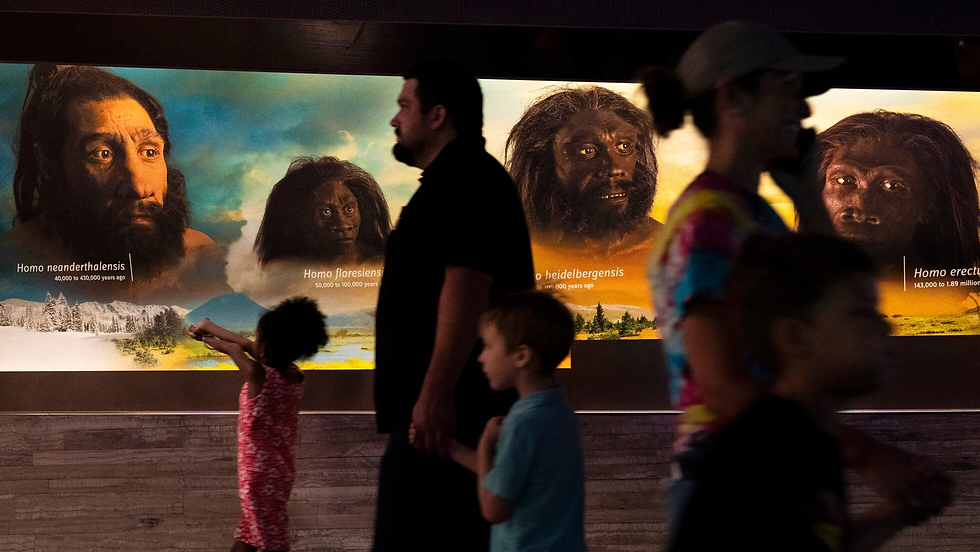The Genetic Legacy of the Neanderthals
- Cecilia Caligiuri

- Aug 23, 2024
- 3 min read
What is the genetic legacy of the Neanderthals? Is it one with more pros or cons for Homo sapiens today? Scientists and anthropologists are learning more about Neanderthals every day, and the discoveries made in the last twenty years have begun to shed light on just how much our ties to these ancient hominids continue to affect our modern lives.
Recent Discoveries Revolutionize Ancient DNA Research:
Scientists have only recently been able to begin connecting the broken pieces of ancient DNA, but continuously more research points to the conclusion that we still carry traits of our old relatives, the Neanderthals. This is mainly thanks to Svante Paabo, a Swedish geneticist who was the first to piece together an entire
Neanderthal genome in 2010 and
later won the Nobel Prize for it in 2022. Before this feat, studying ancient DNA was a major technical challenge as it gradually becomes chemically modified and degrades into short fragments, and is easily contaminated by bacteria or modern humans. Paabo’s accomplishment opened many doors for geneticists and anthropologists as it allowed them to better analyze ancient DNA to study genetic changes over time, whether they were environmental adaptations or seemingly random, as
well as the genetic material modern humans from different areas have.
Costs of Evolution:
So, what are some of the results of these studies? According to Zeberg, a close associate of Paabo, half of the Neanderthal genome still exists in tiny fragments dispersed in most modern humans. Inherited Neanderthal DNA affects homo
sapiens’ fertility, immune systems,
Here are images showing Paabo's research from the Max Plank Institute! and even bodily response to the COVID-19 virus. In 2020, Zeberg & Paabo found that a significant genetic risk factor for acute COVID-19 is inherited from Neanderthals, but a year later they discovered a series of DNA variants along a single chromosome passed down from Neanderthals that protected people from acute COVID-19. Neanderthal DNA has also been connected to Dupuytren contracture, sensitive neuropsychiatric diseases, Graves’ disease, and rheumatoid arthritis in Homo sapiens (read more on some of these below). There is also a gene related to blood clotting which is thought to have been transferred from Neanderthals in Eurasia that was probably useful, as said by well-known paleoanthropologist Rick Potts, in the “rough and tumble world of the Pleistocene,” but now heightens the risk of stroke for older individuals.
Hearing this, you may think that the legacy of the Neanderthals is nothing but bad news for the Homo sapiens, but it wasn’t always. When Homo sapiens left Africa 50,000 years ago, they had no immunity to the diseases in Europe and Asia, but thankfully the Neanderthals (and Denisovans) they began interbreeding with did. However, while this was beneficial to our species then, today it has resulted in some individuals having hypersensitive immune systems.
Research has shown that nose shape is also affected by Neanderthal genetic variants, as is shown in this comparison between the skulls of a modern human (Native American) and Neanderthal.
Other research has tied Neanderthal genetic variants to skin & hair color, nose shape, height, behavioral attributes (such as mood, sleeping patterns, and even addiction), skull shape, Type 2 diabetes, schizophrenia, and other psychotic disorders. One study determined that it is more probable for individuals who feel more pain than others to have a Neanderthal pain receptor, while another study found that a third of the women in Europe have inherited a Neanderthal receptor for the hormone progesterone. This caused them to produce more progesterone receptors in their cells and thus be more sensitive to it, resulting in increased fertility and less miscarriages and bleeding while pregnant.
But what about the Denisovans, another group of ancient humans who were similar to and interbred with the Neanderthals and possibly early modern humans? While much less is known about them, early research suggests that thanks to a gene variant passed down from the Denisovans that aids red blood cells in using oxygen more efficiently, modern Tibetans were able to better adapt to living at high altitudes. More on the Denisovans to come!
Here is a very interesting video called "The Neanderthal in us" by the Max Plank Institute to learn more about Paabo's work and research: https://www.mpg.de/914714/Neandertal
Fun Fact: To examine its biological effects on other living creatures, scientists inserted a gene carried by Neanderthals & Denisovans into mice and were intrigued to find that it resulted in the mice having larger heads and an additional rib!
Diseases/Disorders mentioned above…
Dupuytren contracture: a grave hand disease where the skin abnormally thickens and gradually the fingers of the hand contract toward the palm of the hand leading to partial functio laesa.
Graves’ disease: an autoimmune disorder that causes an overactive thyroid gland (hyperthyroidism).
Rheumatoid arthritis: a chronic autoimmune disorder that mostly targets joints.










Comments